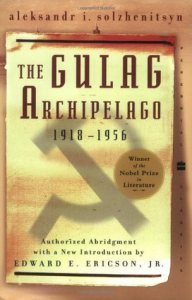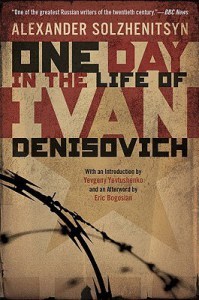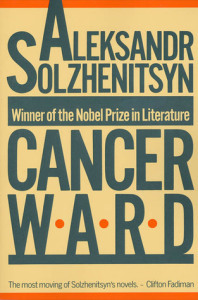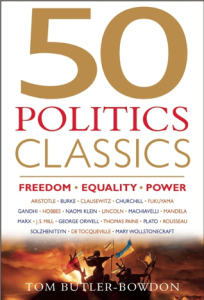Banned Books Month Guest Post from Tom Butler-Bowdon: Running from the State
Alexandr Solzhenitsyn played with his life in writing a book that revealed the horrors of the Soviet Gulag.

Harper Perennial Modern Classics, Reprint Edition, February 2002.
In the blaze of publicity that came with the Nuremberg Trials after World War Two, the full horror of Nazi atrocities was revealed. Stalinist Russia, in contrast, seemed like a much more forgiving regime, and many on the Left in the West still thought that communism was the future.
Yet behind the showreels of happy peasants on their collective farms and joyous factory workers was the reality of mass displacement, starvation and injustice on a scale that not even Hitler could have engineered.
THE GULAG ARCHIPELAGO is Solzhenitsyn’s monument to the millions tortured and murdered in Soviet Russia between the Bolshevik Revolution and the 1950s. He began writing it in 1958, three years after finishing an eight-year sentence in the Gulag labor camps.

NAL, Reprint Edition, August 2009.
Just after finishing his sentence, Solzhenitsyn was pronounced ‘Exile for Life’ and sent to Kok-Terek in southern Kazakhstan for three years where he taught in a primary school, and was able to write secretly. In 1961, after Khrushchev’s speech denouncing Stalin had circulated in Russia, he dared to seek publication of his novel ONE DAY IN THE LIFE OF IVAN DENISOVICH, a fictional rendering of his time in the Ekibastuz labor camp. It brought him acclaim, but as he became more outspoken about censorship his novels CANCER WARD and THE FIRST CIRCLE (both 1968) were banned. He was expelled from the Soviet Writers’ Union, but in 1970 was awarded the Nobel Prize for Literature; he did not attend the ceremony for fear of not being allowed back into the USSR.
After spending ten years on the manuscript of THE GULAG ARCHIPELAGO it was smuggled out of the Soviet Union on mimeograph, and then published in France in 1973 and the United States and Britain in 1974.
In 1974 Solzhenitsyn was arrested, interrogated by the KGB and charged with treason. He was deported to Germany and spent time in Zurich before settling in Cavendish, Vermont.

Farrar, Straus and Giroux, Reissue Edition, November 1991.
When published in America, THE GULAG ARCHIPELAGO was an instant bestseller, helped by the fact that that Solzhenitsyn had been expelled from the Soviet Union and was now living on US soil. To Americans he was living proof of the brutality and Orwellian nature of the Soviet regime.
Isaiah Berlin commented that “Until GULAG, Communists and their allies had persuaded their followers that denunciations of the Soviet regime were largely bourgeois propaganda.” Literally a book that changed minds and changed the world, its existence made it impossible for the USSR to claim moral superiority over capitalism and democracy. Doris Lessing said that “Its importance can hardly be exaggerated. It helped bring down an empire”.
GULAG is based on Solzhenitsyn’s recollections and notes along with reports, letters and reminiscences from 227 witnesses. Yet even as the book was published he declined to list their names. After all, in 1974 Soviet Russia still seemed to be going strong; it was a decade before Gorbachev’s glasnost (‘openness’) and perestroika (‘restructuring’) reforms that would result in the breakup of the Soviet Union.
Solzhenitsyn never imagined that he would get his account of the Gulag published in his lifetime, even less that he would appear on the cover of Time magazine and would win the Nobel Prize for Literature. Yet he was never complacent, for unless each generation learned about the horrors of regimes like Stalin’s, he believed, history was doomed to repeat itself.
After Solzhenitsyn’s book was published in the West it was circulated illegally in the Soviet Union as a samizdat (self-published) text, possession of which could put the owner in prison. It was only with the increasing freedoms allowed under Gorbachev that a third of the book was finally published, over three issues in 1989, in the Russian literary journal Novy Mir.

Nicholas Brealey Publishing, September 2015.
Following the dissolution of the Soviet UnionTHE GULAG ARCHIPELAGO was finally published as a book in its entirety. Solzhenitsyn, who died in 2008, would have been pleased that since 2009 it has been included on core reading lists in Russian high schools.
THE GULAG ARCHIPELAGO covers three volumes and 1800 pages, but if you don’t have the time to devote to the whole work simply read Volume 1, or the excellent abridgement by Edward Ericson (470 pages) which still gives you plenty of details and all the vital insights. There is a lot of Russian history in the book and you may find yourself rushing to look up various events and historical figures to fully understand what Solzhenitsyn is saying. It is thus a history lesson as well as being a literary tour de force (Solzhenitsyn was too modest in describing it as a work of journalism – his distinctive voice runs through it) that will stay with you for life. Harrowing, but impossible to put down.

Tom Butler-Bowdon
Tom Butler-Bowdon is the author of 50 POLITICS CLASSICS: Freedom, Equality, Power (Nicholas Brealey, 2015). His ‘50 Classics books’ covering the great writings in Psychology, Philosophy and Spirituality have sold over 300,000 copies and are published in 24 languages. Tom was educated at the University of Sydney and the London School of Economics. He lives in Oxford, UK.








